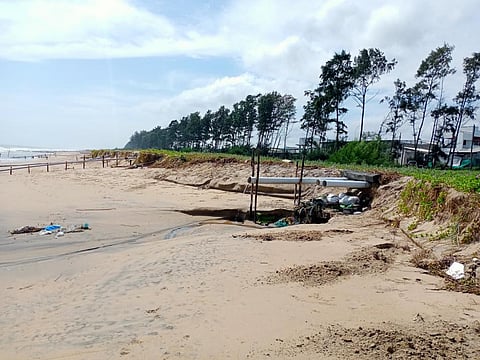

CHENNAI: None of the 65 coastal aquaculture shrimp hatcheries operating on East Coast Road (ECR) of Chengalpet and Villupuram districts have mandatory Coastal Regulation Zone (CRZ) clearance.
Officials of the Tamil Nadu Coastal Zone Management Authority and Department of Environment confirmed that between 2005 and 2019, they have neither issued nor discussed the granting of CRZ clearance to shrimp hatcheries in the State in any of the meetings. The information was obtained through RTI by environmental activist Pooja Kumar of Coastal Resource Centre.
This is a major oversight by the authorities.
The CRZ Notification 2011 lists hatcheries as an activity permitted within certain permissible zones of the CRZ, subject to prior appraisal and recommendation from the State's Coastal Zone Management Authority (SCZMA) and clearance from the statutory authority. The coastal aquaculture industry is also specifically regulated by the Coastal Aquaculture Authority (CAA) Act 2005. Rules framed under this Act prohibit the setting up of all coastal aquaculture facilities, including hatcheries, within 200m of the High Tide Line (HTL) in coastal areas. Any aquaculture activities beyond 200m of the High Tide Line requires statutory licenses from the CAA.
ALSO READ | How 600 cameras, a broken headlight helped nab kidnappers in Chennai
The Coastal Resource Centre has also published a 33-page report titled "Below the Radar" based on site verification, according to which 62 of the 65 hatcheries were operational within 200m of the HTL in blatant violation of the provisions in the CAA Act. None of the hatcheries have valid Consent to Establish or Operate under Water and Air Acts too. The worst offenders are four hatcheries sitting on the ecologically sensitive CRZ 1A areas (sand dunes).
When contacted, senior officials of Tamil Nadu Pollution Control Board (TNPCB) told The New Indian Express that hatcheries are dealt with under the CAA Act and a former official of the Tamil Nadu Coastal Zone Management Authority said it is a huge grey area. "Hatcheries are not as polluting as other industries, but they still need mandatory licenses."
K Saravanan, one of the authors of the report who also photo-documented the violations, says, "Detailed survey of coastal aquaculture hatcheries along all districts in Tamil Nadu must be undertaken and compliance to CRZ Notification, CAA Act and Water and Air Acts of all hatcheries along the TN coast must be verified urgently. Those found in violation must be removed and the natural state of the area restored."
It's a common sight all along the ECR that hatcheries are releasing untreated discharge into ecologically sensitive intertidal CRZ areas. Aquaculture effluent usually contains pharmaceutical waste as medicines are used to prevent infections in the cultured animals. Untreated effluent mixed with chemicals when discharged into intertidal areas affects the health of intertidal life and pollutes nearshore waters and in turn marine life, activists allege.